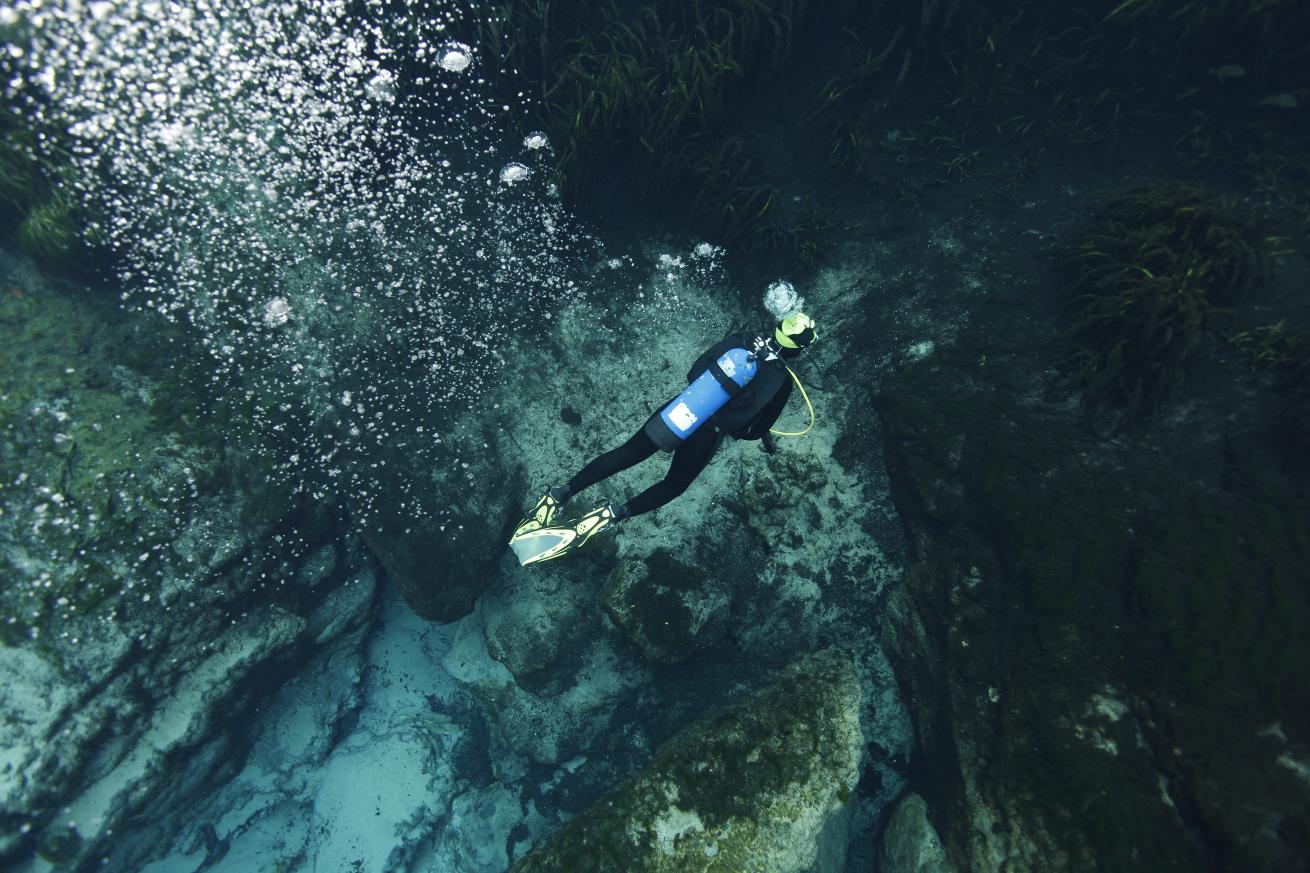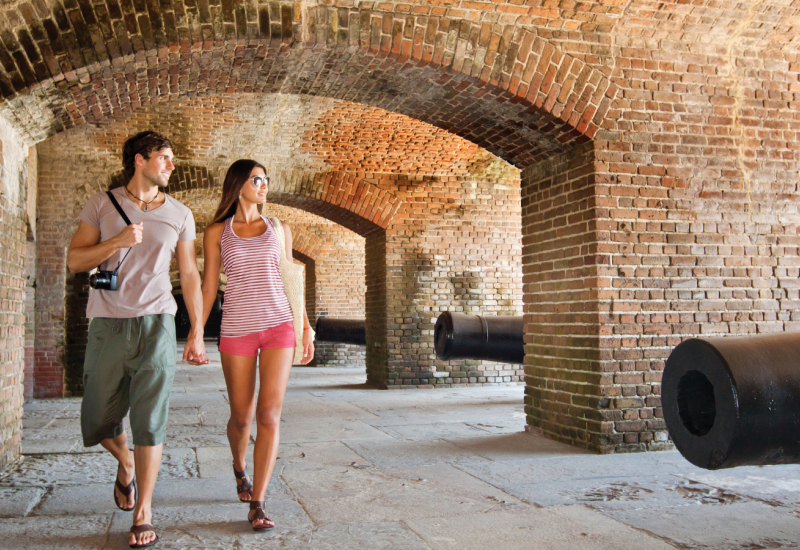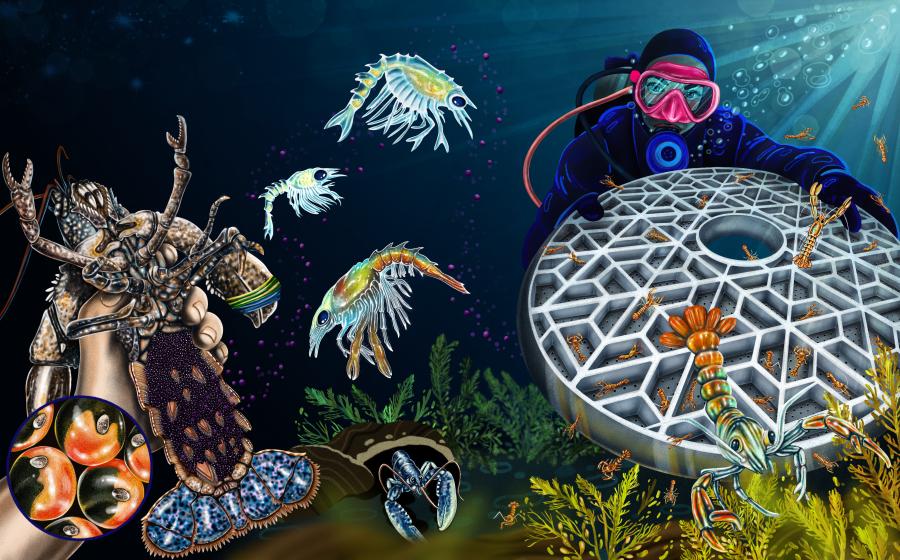Northern Florida Springs

Alexander Springs, Florida
Kaitlin Morris
By Mark Schrope
Photo by Walt Stearns
I'm between two stunning, 50-foot-high cliffs at Little Devil Spring in northern Florida, where diving in a submerged canyon means you've found the ideal way to enjoy the best (and just about only) rocky vistas the state offers. For those willing to look below the surface, the options are nearly endless. On a recent loop through a sliver of Florida's spring country, I find gaping caverns, mysterious underground mazes, and more than a few awe-inspiring sights.
The northwestern quadrant of the Florida peninsula is pockmarked with springs and sinkholes sporting a nearly endless array of rocky passages. For divers, these inland oases support a cast of colorful river characters, including schools of mullet, turtles, and the occasional crayfish or alligator. But the geology here is the main attraction because it offers so much intriguing terrain to explore that even veteran local divers remain enchanted. North Florida offers plenty of marvels for divers with basic certifications to enjoy, but it's also known as one of the best cave-diving destinations on the planet. Besides the mountain-like scenes, fossils abound and divers can even find relics such as ancient mastodon tusks. Of course, spring water that's always 72 degrees, visibility measured in hundreds of feet and easily accessible dives without needing a boat doesn't hurt. With convenient stairways and submerged training decks, the following group of sites stands dive-ready for you to plunge in.
Blue Grotto
This classic sinkhole with sheer limestone sides is an ideal starting point for divers looking for their first taste of underwater exploration in overhead environments. There's a 70-foot-wide entrance to a remarkably safe cavern dive at the base of one end. A single, large cavern angles down from a wide, white sheet of limestone at 25 feet, down to 95 feet. A guideline makes a horseshoe circuit to a group of rocks near the deepest point, pitted with fossilized shells, and then around and back up. So much light comes into this huge cavern it's almost impossible to find a spot where you can't see the way out. Kicking back out, we see a big catfish (whose cousin later makes for a tasty lunch at a nearby diner), and then, exiting the cavern with our eyes readjusting to the bright light, we find a softshell turtle straining its long neck.
Devil's Den
Enter this site through a cut tunnel entrance and descend a long staircase into a spectacular above-water cave chamber--extremely rare in Florida. The entry deck is built on the rubble of rocks that fell long before anyone can remember, to create the ceiling's only hole. The submerged cavern mushrooms under the walls in all directions with depths to 65 feet. Around this perimeter, you'll find a maze of so many swim-throughs and tunnels you may not realize when you've completed your circumnavigation. If you're unsure at any point about entering any swim-through, just turn off your dive light and look for sunlight at the end of a passageway.
Ginnie Springs
While looking down into the cypress-lined pool, you can make out a modest rock outcropping, but it's hardly enough to clue you in to what you're about to see at this area--named after the property's former owner who used to wash her clothes here. Dive down to the outcropping and enter one of two 4-foot-wide entrances. About 20 feet in, you'll find a massive area called the Ballroom. Allow plenty of time and air to explore this cavern that's 60 feet wide, 70 feet long and 25 feet high. There's a pocket in the Ballroom's ceiling just large enough to fit a diver from the waist up, leaving your legs dangling beneath like a chandelier. At the Ballroom's farthest point, with the entrance still visible, grab hold of the steel bars. They block further penetration into the spring's cave system, but they let in the full force of its water flow, which, at 35 million gallons per day, is more than enough to keep your body whipping around like ribbons over an air conditioner vent.
Little Devil to Devil's Ear
The water flow out of the Little Devil slot canyon is the start of a 100-yard run that takes you to the Devil's Eye, a round spring basin that abruptly drops to a sandy bottom at 20 feet. A cavern extends about 30 feet into the wall on one side of the basin before you reach a sign with an illustrated likeness of the grim reaper, warning non-cave divers to halt. This is one of two entrances to a cave system with more than 30,000 feet of mapped passageways. After leaving the cavern, you can follow the spring run out to where clear water mixes with the often reddish-tinted waters of the Santa Fe River. There, beneath a buoy, you'll find Devil's Ear, a 60-foot-deep chimney with water flowing almost hard enough to rip your mask from your face. Look up from the Ear on most days and that dark river water takes on the strange but impressive appearance of billowing clouds of blood. Resting inside the Ear's cave entrance and looking out, the rocks form the shape of a Christmas tree, which on our dive is pierced by a single vertical shaft of sunlight. It's the perfect end to our weekend trip, which is more than enough to inspire further exploration of Florida's beautiful, submerged geological wonders. These springs are why some dedicated locals say they're perfectly content with a diving life sans saltwater.
InDepth
Getting Around: To get to Ginnie Springs from Gainesville, Fla., take Interstate 75 South to Florida Route 121 South , then go west on U.S. 27 Alt. To reach the Ginnie Springs Campground & Dive Resort, which includes the Little Devil run, take U.S. 41 North until reaching the Ginnie Springs sign. Turn left onto NE 182nd Avenue. Continue about seven miles until reaching another sign directing drivers to the springs. To get to Blue Grotto from Atlanta, take 75 South to Gainesville (exit 382) and then take 121 South for 21 miles to Williston. Bear left at Williston Tire and turn right at the next light onto 27. Drive through Williston and after two miles, turn left onto 172nd Court and continue through the stop sign to the entrance gate. To get to Devil's Den follow the same directions for Blue Grotto, but from 27, after about a mile-and-a-half, turn right on NE 180th Ave.
Dive Conditions: Water temperature in the springs and sinks is 72 degrees year-round, so a 5mm full suit should be sufficient. Divers without cave certification and proper equipment should never penetrate beyond the warning signs.
Dive Outfitters: Blue Grotto (divebluegrotto.com), Devil's Den, (devilsden.com), Ginnie Springs Outdoors, (ginniespringsoutdoors.com). Daily dive fees range from $30 to $40 and are open to all certified divers. Divers must also attend orientation sessions explaining safe cavern diving procedures.

Kaitlin MorrisAlexander Springs, Florida
By Mark Schrope
Photo by Walt Stearns
I'm between two stunning, 50-foot-high cliffs at Little Devil Spring in northern Florida, where diving in a submerged canyon means you've found the ideal way to enjoy the best (and just about only) rocky vistas the state offers. For those willing to look below the surface, the options are nearly endless. On a recent loop through a sliver of Florida's spring country, I find gaping caverns, mysterious underground mazes, and more than a few awe-inspiring sights.
The northwestern quadrant of the Florida peninsula is pockmarked with springs and sinkholes sporting a nearly endless array of rocky passages. For divers, these inland oases support a cast of colorful river characters, including schools of mullet, turtles, and the occasional crayfish or alligator. But the geology here is the main attraction because it offers so much intriguing terrain to explore that even veteran local divers remain enchanted. North Florida offers plenty of marvels for divers with basic certifications to enjoy, but it's also known as one of the best cave-diving destinations on the planet. Besides the mountain-like scenes, fossils abound and divers can even find relics such as ancient mastodon tusks. Of course, spring water that's always 72 degrees, visibility measured in hundreds of feet and easily accessible dives without needing a boat doesn't hurt. With convenient stairways and submerged training decks, the following group of sites stands dive-ready for you to plunge in.
Blue Grotto
This classic sinkhole with sheer limestone sides is an ideal starting point for divers looking for their first taste of underwater exploration in overhead environments. There's a 70-foot-wide entrance to a remarkably safe cavern dive at the base of one end. A single, large cavern angles down from a wide, white sheet of limestone at 25 feet, down to 95 feet. A guideline makes a horseshoe circuit to a group of rocks near the deepest point, pitted with fossilized shells, and then around and back up. So much light comes into this huge cavern it's almost impossible to find a spot where you can't see the way out. Kicking back out, we see a big catfish (whose cousin later makes for a tasty lunch at a nearby diner), and then, exiting the cavern with our eyes readjusting to the bright light, we find a softshell turtle straining its long neck.
Devil's Den
Enter this site through a cut tunnel entrance and descend a long staircase into a spectacular above-water cave chamber--extremely rare in Florida. The entry deck is built on the rubble of rocks that fell long before anyone can remember, to create the ceiling's only hole. The submerged cavern mushrooms under the walls in all directions with depths to 65 feet. Around this perimeter, you'll find a maze of so many swim-throughs and tunnels you may not realize when you've completed your circumnavigation. If you're unsure at any point about entering any swim-through, just turn off your dive light and look for sunlight at the end of a passageway.
Ginnie Springs
While looking down into the cypress-lined pool, you can make out a modest rock outcropping, but it's hardly enough to clue you in to what you're about to see at this area--named after the property's former owner who used to wash her clothes here. Dive down to the outcropping and enter one of two 4-foot-wide entrances. About 20 feet in, you'll find a massive area called the Ballroom. Allow plenty of time and air to explore this cavern that's 60 feet wide, 70 feet long and 25 feet high. There's a pocket in the Ballroom's ceiling just large enough to fit a diver from the waist up, leaving your legs dangling beneath like a chandelier. At the Ballroom's farthest point, with the entrance still visible, grab hold of the steel bars. They block further penetration into the spring's cave system, but they let in the full force of its water flow, which, at 35 million gallons per day, is more than enough to keep your body whipping around like ribbons over an air conditioner vent.
Little Devil to Devil's Ear
The water flow out of the Little Devil slot canyon is the start of a 100-yard run that takes you to the Devil's Eye, a round spring basin that abruptly drops to a sandy bottom at 20 feet. A cavern extends about 30 feet into the wall on one side of the basin before you reach a sign with an illustrated likeness of the grim reaper, warning non-cave divers to halt. This is one of two entrances to a cave system with more than 30,000 feet of mapped passageways. After leaving the cavern, you can follow the spring run out to where clear water mixes with the often reddish-tinted waters of the Santa Fe River. There, beneath a buoy, you'll find Devil's Ear, a 60-foot-deep chimney with water flowing almost hard enough to rip your mask from your face. Look up from the Ear on most days and that dark river water takes on the strange but impressive appearance of billowing clouds of blood. Resting inside the Ear's cave entrance and looking out, the rocks form the shape of a Christmas tree, which on our dive is pierced by a single vertical shaft of sunlight. It's the perfect end to our weekend trip, which is more than enough to inspire further exploration of Florida's beautiful, submerged geological wonders. These springs are why some dedicated locals say they're perfectly content with a diving life sans saltwater.
InDepth
Getting Around: To get to Ginnie Springs from Gainesville, Fla., take Interstate 75 South to Florida Route 121 South , then go west on U.S. 27 Alt. To reach the Ginnie Springs Campground & Dive Resort, which includes the Little Devil run, take U.S. 41 North until reaching the Ginnie Springs sign. Turn left onto NE 182nd Avenue. Continue about seven miles until reaching another sign directing drivers to the springs. To get to Blue Grotto from Atlanta, take 75 South to Gainesville (exit 382) and then take 121 South for 21 miles to Williston. Bear left at Williston Tire and turn right at the next light onto 27. Drive through Williston and after two miles, turn left onto 172nd Court and continue through the stop sign to the entrance gate. To get to Devil's Den follow the same directions for Blue Grotto, but from 27, after about a mile-and-a-half, turn right on NE 180th Ave.
Dive Conditions: Water temperature in the springs and sinks is 72 degrees year-round, so a 5mm full suit should be sufficient. Divers without cave certification and proper equipment should never penetrate beyond the warning signs.
Dive Outfitters: Blue Grotto (divebluegrotto.com), Devil's Den, (devilsden.com), Ginnie Springs Outdoors, (ginniespringsoutdoors.com). Daily dive fees range from $30 to $40 and are open to all certified divers. Divers must also attend orientation sessions explaining safe cavern diving procedures.










